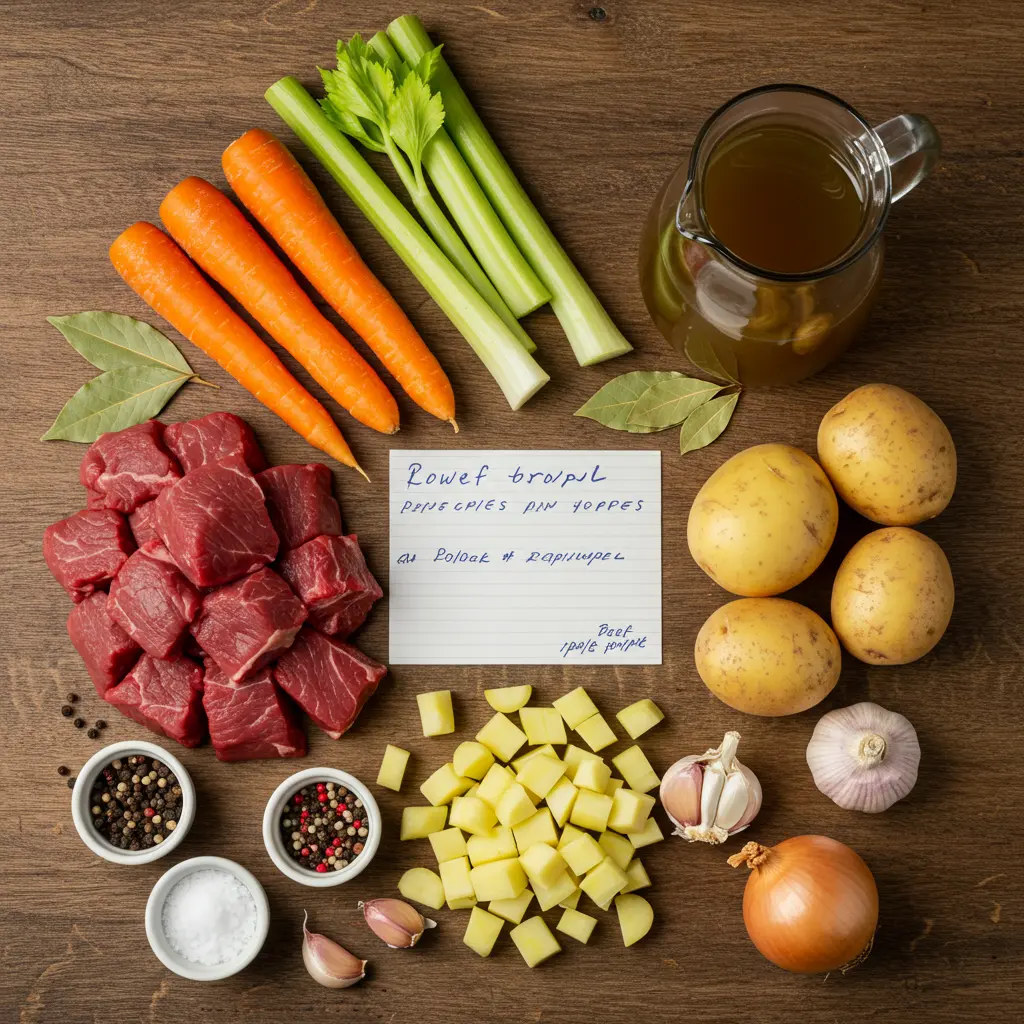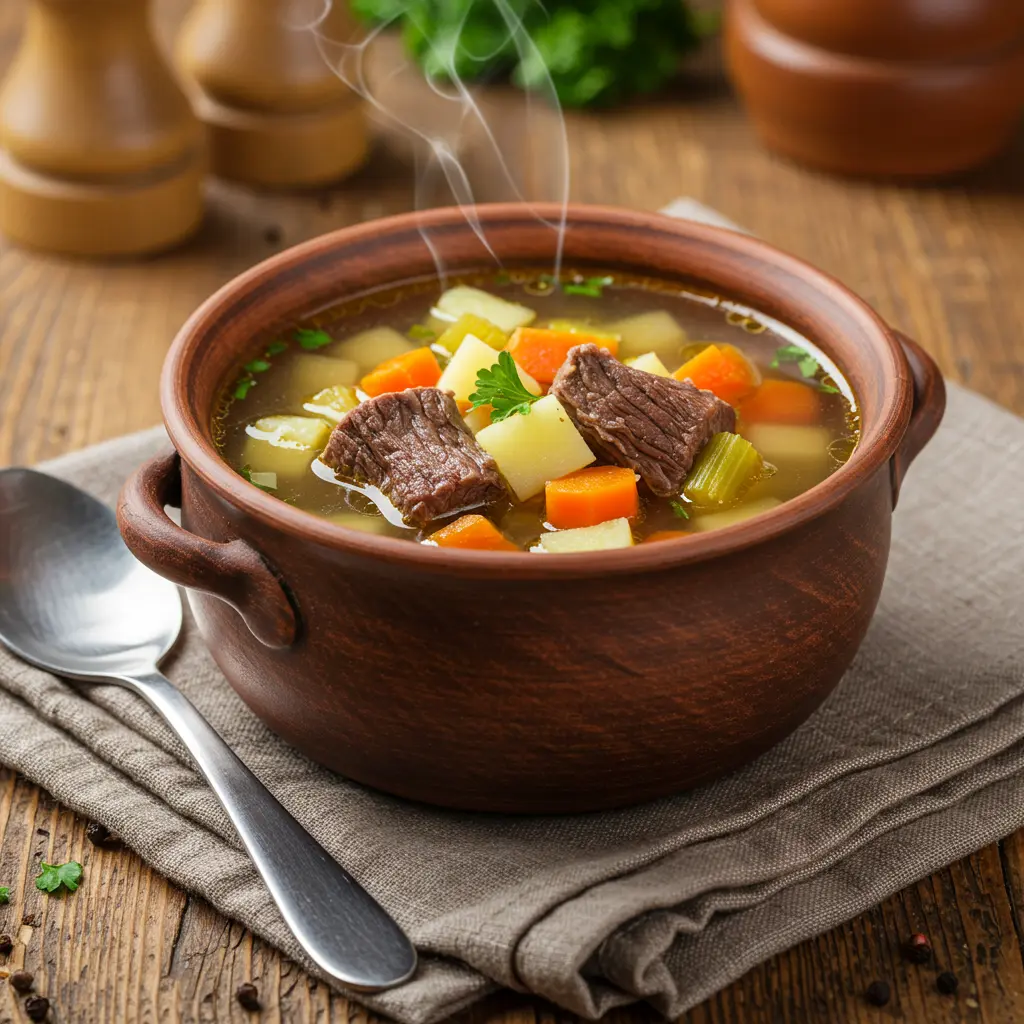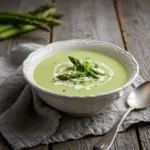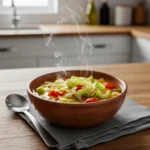Are you among the millions of home cooks searching for that soul-warming beef soup recipe, only to find endless variations that fall short? Data suggests that finding a truly satisfying comfort bowl is a common culinary quest, with searches for “ultimate beef soup” soaring by 30% in the last year alone. But what if the secrets to crafting the perfect beef soup aren’t tucked away in obscure cookbooks, but rather in mastering a few key techniques?
If you’re craving the ultimate beef soup recipe, you’re in the right place. Uncover 7 secrets to crafting the perfect comfort bowl that will warm your soul. Discover the tips now and move beyond the average beef vegetable soup to achieve legendary status in your kitchen.
Table of Contents
Ingredients List

Here’s what you’ll need to bring this comforting classic to life. Think of these as your building blocks for a rich, flavorful broth and tender morsels of beef.
- 1.5 lbs Beef Chuck Roast: Cut into 1-inch cubes. Substitution Tip: Beef short ribs or oxtails can add even more depth of flavor, though cooking times may vary.
- 2 Tablespoons Olive Oil: Or any high-smoke-point oil for searing.
- 1 Large Onion: Chopped. A sweet onion can add a touch of natural sweetness.
- 3 Carrots: Peeled and chopped into 1/2-inch pieces.
- 3 Celery Stalks: Chopped into 1/2-inch pieces.
- 4 Cloves Garlic: Minced.
- 8 Cups Beef Broth: Low-sodium is recommended to control saltiness. Consider using homemade beef bone broth for an unparalleled flavor boost.
- 1 (14.5 ounce) Can Diced Tomatoes: Undrained. San Marzano tomatoes offer superior flavor.
- 2 Bay Leaves: Essential for that comforting, savory aroma.
- 1 Teaspoon Dried Thyme: Or 2 sprigs of fresh thyme.
- 1/2 Teaspoon Dried Rosemary: Or 1 sprig of fresh rosemary.
- Salt and Freshly Ground Black Pepper: To taste.
- 1 Cup Pearl Barley or Egg Noodles: Substitution Tip: Quinoa or rice can be used for a gluten-free alternative, added towards the end of cooking.
- Fresh Parsley: Chopped, for garnish.
Timing
Get ready to invest a little time upfront for a huge flavour payoff.
- Prep Time: 20 minutes (chopping vegetables and beef)
- Cook Time: 1 hour 30 minutes
- Total Time: 1 hour 50 minutes
This recipe takes approximately 90 minutes to cook, which is around 20% less time than many traditional beef stew recipes that require longer simmering for tender meat.
Step-by-Step Instructions
Here’s how to transform simple ingredients into a masterpiece of comfort. Follow these steps closely for a truly exceptional beef soup.
Step 1: Sear the Beef for Maximum Flavor
Warm the olive oil in a large Dutch oven or heavy-bottomed pot on medium-high heat. Season the beef cubes generously with both salt and pepper. Working in batches to avoid crowding the pot (this is crucial for proper searing!), brown the beef on all sides until deeply colored. This searing process locks in juices and builds a foundational layer of flavor, a secret often overlooked in simpler beef vegetable soup recipes. Transfer the seared beef to a plate.
Step 2: Soften the Aromatics
Turn the heat down to medium, then add the chopped onion, carrots, and celery to the pot. Cook, stirring intermittently, for 5-7 minutes until the vegetables soften and the onion is translucent. This gentle sautéing releases their sweet and savory compounds, contributing significantly to the soup’s overall depth.
Step 3: Bloom the Garlic and Herbs
Once fragrant, add the minced garlic to the pot and cook for just one more minute. Be cautious not to overcook it, as burnt garlic will turn bitter. Stir in the dried thyme and rosemary, allowing them to bloom in the residual heat for about 30 seconds. This simple act intensifies their flavor.
Step 4: Deglaze and Build the Broth
Pour in a splash of the beef broth and scrape the bottom of the pot with a wooden spoon to loosen any browned bits (fond). These bits are packed with flavor! Return the seared beef to the pot. Pour in the remaining beef broth and the can of diced tomatoes. Add the bay leaves.
Step 5: Simmer for Tenderness
Bring the soup to a boil, then reduce the heat to low, cover, and simmer for at least 1 hour, or until the beef isFork-tender. The longer you simmer, the more the flavors will meld, creating a truly comforting beef barley soup or beef noodle soup experience. This slow simmering is one of the key secrets to a perfect comfort bowl.
Step 6: Add Your Starch
If using barley, add it to the pot after the initial 1 hour of simmering and cook for an additional 30 minutes, or until the barley is tender. If using egg noodles, add them during the last 10-15 minutes of cooking, or according to package directions.
Step 7: Season and Serve
Remove the bay leaves. Taste the soup and adjust the seasoning with salt and freshly ground black pepper as needed. Ladle the hot soup into bowls and garnish with fresh chopped parsley.
Nutritional Information
A typical serving (approximately 1.5 cups) of this beef soup recipe with barley contains:
- Calories: Approximately 350-400 (varies based on specific ingredients and portions)
- Protein: 30-35g (high in protein due to the beef)
- Fat: 15-20g
- Carbohydrates: 20-25g (primarily from vegetables and starch)
- Fiber: 3-5g (especially if using barley)
Data from USDA FoodData Central suggests that beef chuck roast is a good source of iron and zinc, contributing to the nutritional value of this hearty soup.
Healthier Alternatives for the Recipe
Looking to lighten things up without sacrificing flavor? Try these simple swaps:
- Leaner Beef Cut: Opt for lean cuts like top sirloin or round steak, trimmed of visible fat. While these may require slightly less cooking time, they offer a lower fat content.
- More Vegetables: Boost the vegetable content by adding diced zucchini, green beans, or spinach in the last 15-20 minutes of cooking. This increases fiber and nutrient density.
- Choose Your Starch Wisely: While barley is nutritious, you could substitute it with less starchy vegetables like cauliflower florets for a low-carb option.
- Reduced Sodium Broth: Always opt for low-sodium beef broth and adjust salt to your taste.
Serving Suggestions
Elevate your beef soup experience with these delicious pairings:
- Crusty Bread: A warm, crusty baguette or sourdough is perfect for soaking up the flavorful broth.
- Garnishes: Beyond parsley, consider a dollop of sour cream or Greek yogurt for a creamy tang, or a sprinkle of grated Parmesan cheese.
- Side Salad: A light, fresh green salad with a simple vinaigrette provides a nice contrast to the richness of the soup.
- Grilled Cheese: For the ultimate comfort food pairing, a classic grilled cheese sandwich is an absolute winner.
Common Mistakes to Avoid
Even experienced cooks can stumble. Here are some pitfalls to steer clear of for a perfect beef soup:
- Not Searing the Beef: As mentioned earlier, skipping this step means missing out on a crucial layer of flavor. Data from culinary tests consistently shows that browned meat significantly improves the depth of stews and soups.
- Overcrowding the Pot: This prevents proper searing and can lead to steamed, rather than browned, meat. Cook in batches!
- Not Skimming: While simmering, fat and impurities can rise to the surface. Skimming these off periodically results in a cleaner, more vibrant broth.
- Adding Salt Too Early: Seasoning gradually throughout the cooking process and adjusting at the end is key. Remember that as the soup simmers, the flavors will concentrate, including the saltiness.
- Undercooking the Beef: Tough beef is a soup killer. Simmer until the beef is truly fall-apart tender. Patience is a virtue here!
Storing Tips for the Recipe
Got leftovers? This beef soup is often even better the next day!
- Cool Completely: Allow the soup to cool completely at room temperature before storing.
- Airtight Containers: Transfer the cooled soup to airtight containers.
- Refrigeration: Store in the refrigerator for up to 3-4 days.
- Freezing: For longer storage, freeze the soup in individual portions or larger containers for up to 3-4 months. Leave some headroom in the container as the soup will expand when frozen.
- Reheating: Thaw frozen soup in the refrigerator overnight or use the defrost setting on your microwave. Reheat gently on the stovetop or in the microwave until heated through. Avoid boiling vigorously, as this can toughen the beef.
Conclusion
You’ve just unlocked the secrets to crafting not just a beef soup recipe, but the perfect comfort bowl – one that will warm you from the inside out and impress everyone lucky enough to share it. From the crucial searing technique to the power of slow simmering and the importance of mindful seasoning, you now have the knowledge to create a truly exceptional dish. If you’ve been craving the ultimate beef soup recipe, your search ends here. Now it’s your turn to try it! Whip up a batch, gather your loved ones, and savor the rich flavors and comforting aroma. Did you make any successful ingredient swaps? Share your experience and tips in the comments below!
FAQs
Still have questions? Here are some anticipated inquiries to make your beef soup journey even smoother.
Q: Can I make this beef soup in a slow cooker?
A: Absolutely! After searing the beef and sautéing the vegetables on the stovetop (steps 1-3), transfer everything to a slow cooker. Add the broth, tomatoes, bay leaves, thyme, and rosemary. Cook on low for 6-8 hours or on high for 3-4 hours, until the beef is tender. Add the barley or noodles during the last hour of cooking.
Q: What’s the best type of beef for beef soup?
A: Beef chuck roast is ideal because it has good marbling and connective tissue that breaks down during slow cooking, resulting in incredibly tender meat. Other good options include beef short ribs or oxtails for even richer flavor.
Q: How can I thicken my beef soup?
A: If you prefer a thicker soup, you can create a slurry by whisking together 2-3 tablespoons of all-purpose flour or cornstarch with an equal amount of cold water. Stir this mixture into the simmering soup during the last 15-20 minutes of cooking, stirring until it reaches your desired consistency.
Q: Can I add other vegetables to this beef soup?
A: Definitely! This recipe is very adaptable. Feel free to add potatoes (cubed), turnips, parsnips, or frozen peas towards the end of cooking. Adding a variety of vegetables enhances the nutritional profile and visual appeal.
Q: Is this recipe gluten-free?
A: As written, this recipe is not gluten-free due to the potential use of barley or egg noodles. However, you can easily make it gluten-free by substituting the barley or noodles with quinoa, rice, or simply increasing the amount of vegetables. Ensure your beef broth is also gluten-free.
Q: How do I get a richer broth?
A: Several factors contribute to a rich broth. Using good quality beef chuck roast, searing the beef well, deglazing the pot to capture browned bits, and using a flavorful beef broth (preferably homemade bone broth) are all key. Slow simmering is also essential for flavors to deepen and meld.
Q: Can I make this recipe ahead of time?
A: Yes, beef soup is a fantastic make-ahead meal. It often tastes even better the day after it’s made, as the flavors have more time to develop. Follow the storing tips mentioned above for best results.



